|
|
 |
 |
| The Meanings of Images |
|
|
The devotional art of Hinduism portrays a wide range of deities and saints in seemingly infinite diversity. In part, this is owing to the wide range of practices and beliefs encompassed in the term "Hinduism." The word "Hindu" is related to the name of the river Indus, and has been used primarily by outsiders to define and characterize adherents of the religious traditions found in the region of this river since the early centuries of the second millennium. In the modern period, the term "Hinduism" was coined to denote a distinct and singular religion along Western lines, though in fact the term is applied to a wide range of practices. The grouping of different traditions under one name does not completely explain the many Gods associated with Hinduism, however: diversity is also a fundamental aspect of the tradition described by the term. The Upanishads, an important type of philosophical and ritual text, contain an oft-quoted section that asserts that while there are millions of Gods there is yet one, demonstrating the multiplicity of understanding and affiliation that characterizes the Hindu tradition, however it may be defined. Many Hindus, in fact, identify this acceptance and celebration of diverse beliefs and practices as one of the great strengths of the tradition.
The deities and saints that occupy a central place in the Hindu tradition are portrayed in the literature and art that developed in the Gupta (4th-6th centuries) and post-Gupta (7th century on) periods in South Asia, when Hinduism as we know it today began to take shape. Exemplary texts are the epics -- the Mahabharata and Ramayana -- and the Puranas. The epics, both probably compiled around the beginning of the Common Era, are tales of heroes, warriors, and battles. The Mahabharata recounts the massive conflict between the Pandavas and Kauravas; it contains the Bhagavad Gita, which describes a conversation between the hero Arjun and his charioteer, Krishna, who is an incarnation (avatara) of the great God Vishnu (Figure 1). The Ramayana relates the tale of the king Rama, also considered to be an incarnation of Vishnu, who was exiled from his kingdom for fourteen years in the company of his wife, Sita, and his brother Lakshmana.
The Puranas are genealogical, quasi-historical, and mythological texts that describe both kings and Gods. They provide core stories of the Gods who were to take a central place within the developing religion: Vishnu (Figure 1), Shiva (Figure 2), Brahma (Figure 3), and the Goddess (Figure 4), among others. Many of the well-known Gods of Hinduism appear in some form in the Vedas, ritual texts from around the second millennium B.C.E.: Vishnu is present as a solar deity, and Shiva can be identified with the ferocious Rudra. Vishnu, Shiva, and the Goddess are the three main deities worshiped in Hindu practice. Those who worship Vishnu are "Vaishnava," those who worship Shiva are "Shaiva," and those who worship the Goddess are "Shakta" (from shakti, or "power," a feminine force the Goddess is said to embody). Brahma is often identified as the third in a triad that includes Shiva and Vishnu, and although this grouping is commonly portrayed in contemporary poster art, Brahma himself is not often the object of worship. Other deities are increasingly popular: Ganesha (Figure 5), the son of Shiva and Parvati; Hanuman, the monkey-God who aided Rama in the Ramayana; and new forms of the Goddess. Many Gods are accompanied by animal mounts, such as the bull Nandi portrayed with Shiva. It is important to note that although there are many deities represented in the Hindu pantheon, worshipers generally consider the deity they are engaged in worshiping to be the most important; other deities are subservient to him or her. The Gods are also seen as manifestations of one central force in the universe, and therefore many Hindus today, as in the past, see themselves as believing in one single God that takes form in endlessly diverse ways.
Many other deities appear in the devotional arts of South and Southeast Asia, and these deities are often only peripherally related, or completely unrelated, to the major deities described above. Local regional deities, some particular to a single village, are commonly worshiped and portrayed in local arts. These deities are often worshiped without the intervention of the Brahmin or high-caste ritual specialists who usually control ritual interactions in the large temples of the major deities. Connections are also made between local Gods and Goddesses and the pan-Indian deities mentioned above: a local manifestation of the Goddess may be tied to a better-known form of the Goddess, and a local hero-saint may be considered to be an incarnation of one of the great Gods or lesser deities. The city of Madurai in South India is devoted to the Goddess Minakshi and her great husband Shiva, known as Sundareshwara -- deities tied to pan-Hindu traditions that represent a specific local tradition. The village Goddess Chellattamman, whose temple lies not far from the central Minakshi temple within the temple complex (Figure 6), is brought once a year in her movable form to the Minakshi temple to receive protecting power from Shiva -- and, according to her devotees, to marry him. She then returns to her own shrine and receives offerings of animal sacrifice made by her non-Brahmin priests. This would not be acceptable in the vegetarian, Brahmin-controlled temple at Minakshi. Holy persons and saints can also be found in the religious arts of South and Southeast Asia (Figure 7); sometimes these figures are thought to be wholly human, but in other cases they are believed to embody elements of divinity.
There is thus a wide range of deities found in the Hindu pantheon: some only accept vegetarian offerings and some accept a wider range of offerings; some are worshiped within the confines of the high-caste hierarchy and others are not; some are related to pan-regional traditions, and some are entirely local and particular.
< previous next >
Top |
|
 |
 |
| Click for details |
 |
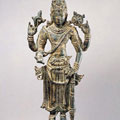 |
 |
Fig. 1
|
 |
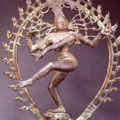 |
 |
Fig. 2
|
 |
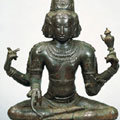 |
 |
Fig. 3
|
 |
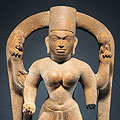 |
 |
Fig. 4
|
 |
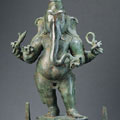 |
 |
Fig. 5
|
 |
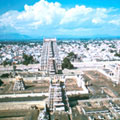 |
 |
Fig. 6
|
 |
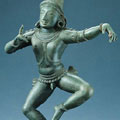 |
 |
Fig. 7
|
 |
|
 |


